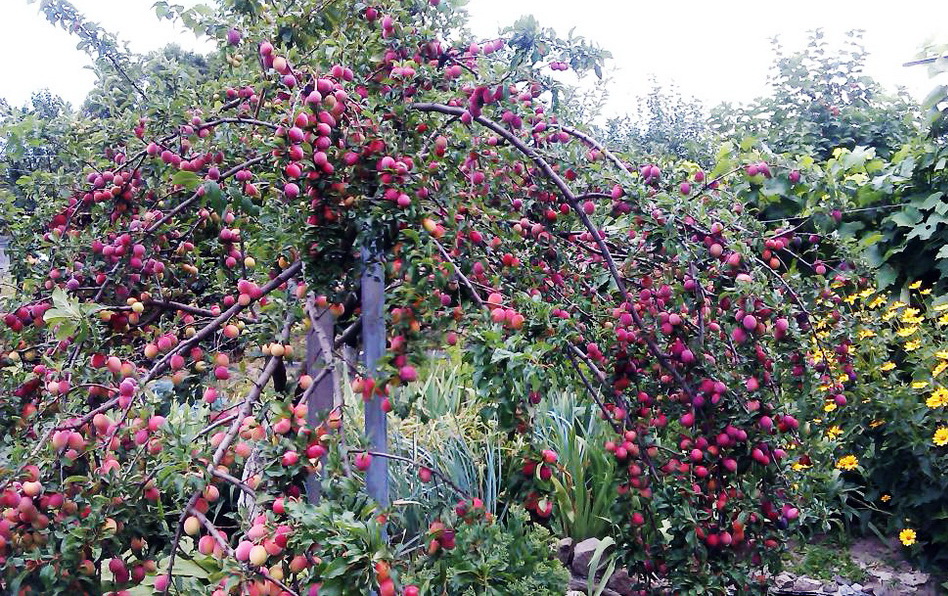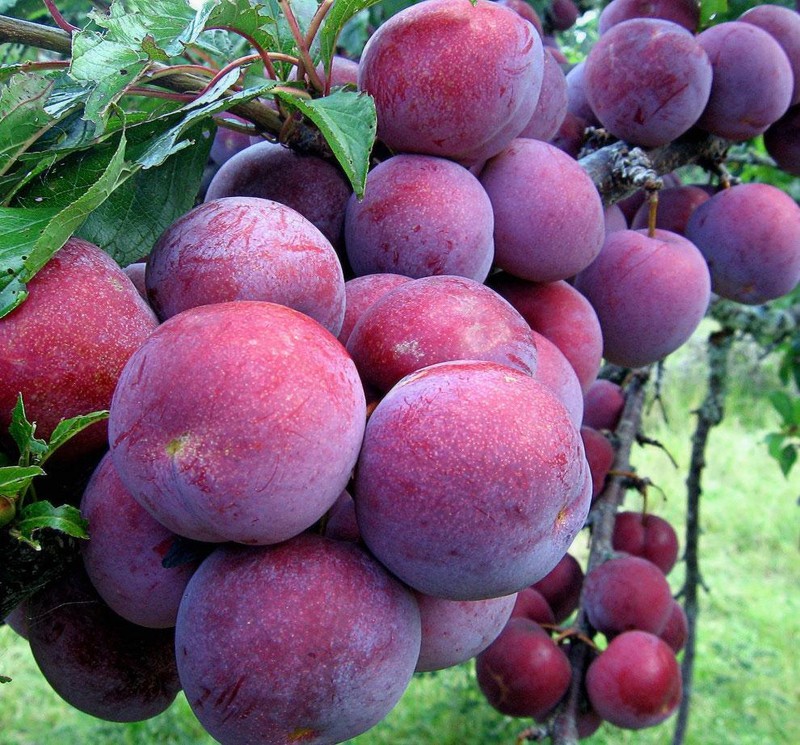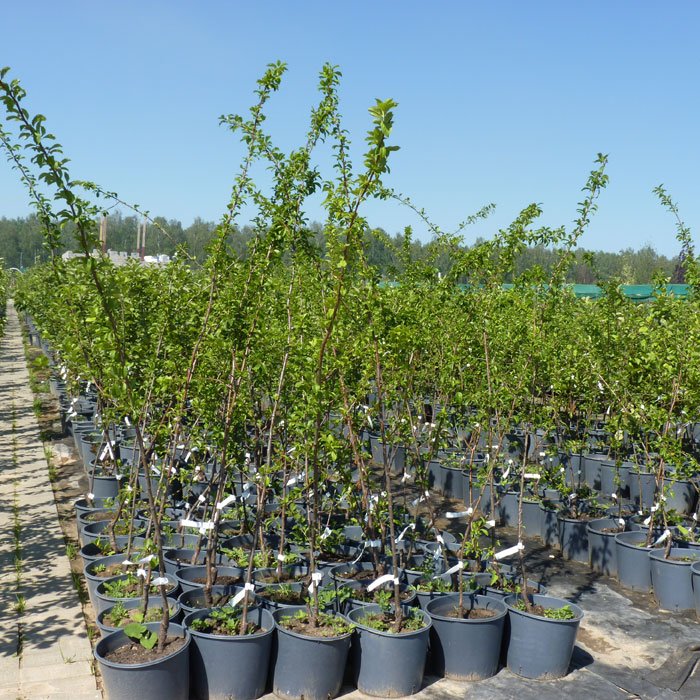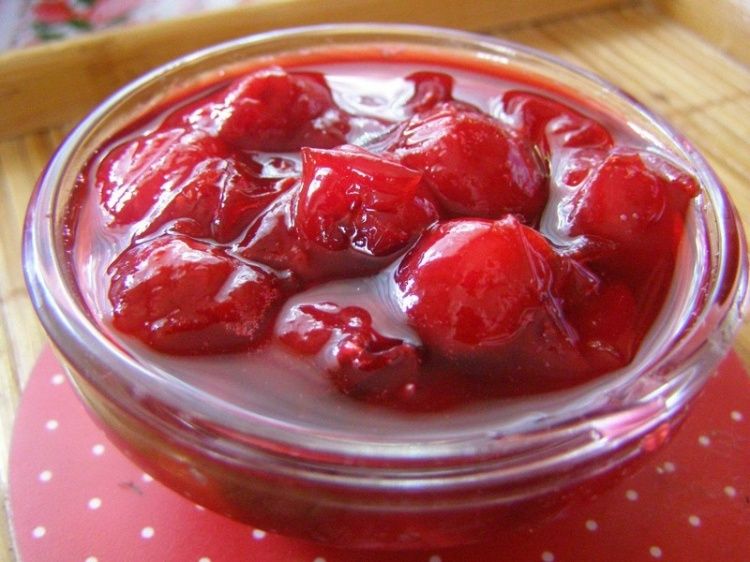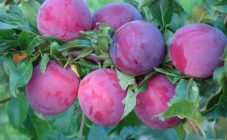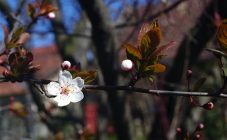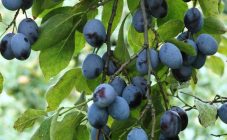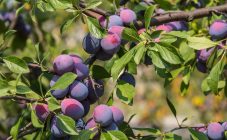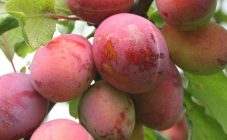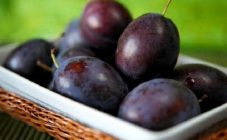Content:
This culture belongs both to the category of decorative (it has reddish foliage, which will decorate any garden) and fruitful (its fruits are edible, they can be processed and stored). This variety of plums tolerates winter well, and is also resistant to lack of moisture, which means that it requires minimal maintenance.
History of appearance
The plant began to gain popularity among gardeners and gradually spread to their plots in 2003. It was brought out by the famous Belarusian breeder Valery Matveev, who is the author of many hybrids with excellent taste and spread from Belarus to many countries. Cherry plum Lama is a hybrid of the common cherry plum and the Ussuri plum.
The purpose of creating this variety of cherry plum is to combine the following characteristics in one plant:
- Resistance to frost and cold, characteristic of plums with the hardiness that cherry plum possesses;
- Low susceptibility to pests and diseases;
- Optimum taste of cherry plum and plum, to bring them closer to the level of dessert;
- Accelerated ripening of fruits.
Variety characteristics
Red cherry plum belongs to low varieties. It rarely grows above 2 meters, its standard height is 1.3-1.5 meters. The crown of the plant is characterized by compactness, it must be formed, since the cherry plum variety with red leaves also has decorative properties. A tree with a semicircular crown looks most impressive. It should be borne in mind that over time, the plum bark begins to darken and becomes rough. However, while the shoots are still young, the bark is very smooth and pleasant to the touch.
The leaves of the plant resemble a lancet in shape and taper towards the base. Their standard length is 15-18 centimeters. The shape of the leaf is finely serrated, and the color consists of two colors: the leaves are green on top, and reddish below (closer to burgundy). The color of the underside of the leaf is uneven; it gradually changes color to brown with a warm chocolate tint.
During the flowering period, the red-leaved cherry plum also looks very beautiful. Inflorescences are small bouquets (several flowers, no more than 3-3.5 centimeters wide, are attached together on a bouquet twig). The petals are white and pink.
Description of the cherry plum variety Lama would be incomplete without a story about its fruits. They are quite large, have a rounded-oval shape, and their weight varies from 15 to 40 grams. The fruit is quite fleshy, its pulp is very juicy, with an exquisite aroma of fruits and almonds. The color of the fruit is purple, dark, under the dense skin, which allows the fruit to be kept intact for a long time and is easy to transport, you can sometimes find grayish dots. The stone of the Russian plum is small and easily separates from the fleshy and fibrous pulp of a dark red color.
The tasters of cherry Lama gave a rather high mark of 4.4 points.This is due to the richness of taste - it combines sweetness with sourness, which is most pronounced near the stone. The fruit is very healthy. It contains acids necessary for humans (malic and citric), easily digestible sugar.
An important characteristic and advantage of this variety of cherry plum is its frost resistance, which allows it to be grown not only in the southern regions of Russia, but also in Siberia and the Far East.
The described culture has inherited drought resistance from cherry plum (it is able to withstand heat of 40 degrees without losing the volume and quality of the crop) and frost resistance of the Ussuri plum. However, frequent changes in temperature can be detrimental to the plant, when a thaw sets in during the day, and severe frost returns at night.
If winter passes early, without any significant temperature fluctuations, then the flowering of red-leaved cherry plum will begin a little later than in most other plants, therefore it has, among other things, resistance to spring frosts. It should be noted that for the formation of fruits next to the described culture, it is necessary to plant related plants, since the cherry plum variety Alma cannot reproduce itself. The optimal pollinator is, of course, the Ussuri plum or cherry plum, but the following varieties can also be used as such: Mara, Kometa, Vitba.
In the description of red-leaved cherry plum, its yield should be noted. The beginning of fruiting usually occurs in the third year after planting the tree. The harvest volume can reach 40 kg. Later, with proper care and adherence to all recommendations, the yield can be up to 300 kg per tree.
Agricultural technology of cultivation
Despite the fact that the described type of fruit is absolutely undemanding to the conditions where it grows, some recommendations should still be followed.
In terms of location, the western side of a small hill is best suited. It is not forbidden to plant in the lowlands, but the quality of the crop will be noticeably worse. Groundwater, preferably, should be at a level not higher than 1.5 meters from the water surface. The plant does not tolerate acidic or alkaline soils; optimal yield is achieved when planting on neutral. At the time of planting, it is imperative to make a drainage layer.
For planting, it is recommended to choose one - or biennial shoots. Move seedlings from one site to another or from a store to a site only in special containers. A few hours before planting, the roots should be abundantly moistened. If necessary, clay and a growth stimulant can be added to the water.
Next, drainage should be placed in the planting pit, a support should be installed and fertile soil mixed with fertilizers should be poured.
The landing sequence is as follows:
- A shoot is placed in the prepared soil so that the neck of the root is at a depth of 3-4 centimeters from the level of the hole.
- The pit is covered with soil.
- The shoot is tied with a tape to the installed support and, if necessary, cut off by no more than 1/3.
- The top layer of soil is trampled down, poured with a bucket of water and mulching is performed.
In terms of care, the plant is absolutely unpretentious. It is enough to loosen the soil to ensure access of water and air to the roots, and also to remove weeds.Crown formation should be done in spring while the plant is still dormant. It is recommended to leave no more than 11-12 skeletal branches after pruning. In the autumn, it is advisable to whitewash the trunks and wrap them with newspaper or burlap to prevent damage to the bark by rodents. Watering the Russian plum is necessary only during a prolonged drought in the amount of no more than two buckets. If necessary, fertilizing can be carried out.
Ripe fruits are recommended to be harvested at least once every two days in order to prevent them falling and spoiling. The unripe cherry plum Lama can be stored in the basement for three months. It is recommended to eat it fresh, you can also make jam, sauces, jam or compote.
Advantages and disadvantages
The advantages of the variety are:
- Resistance to frost, drought, rain and other atmospheric phenomena;
- Fast ripening of fruits;
- High productivity;
- Good taste;
- The ability to transport over long distances;
- Resistance to many diseases and pests;
- Attractive appearance, which allows the culture to be used for decorative purposes.
Among the disadvantages, experienced gardeners highlight the need for pollinators, annual pruning and the possibility of shedding ripe fruits.
Thus, cherry plum Lama is a rather tasty fruit that is not difficult to grow. For this reason, he has gained a well-deserved popularity among gardeners. In addition, this culture is an excellent decoration for the site.


